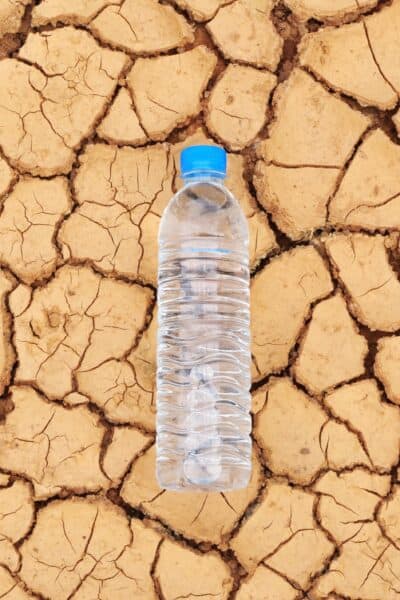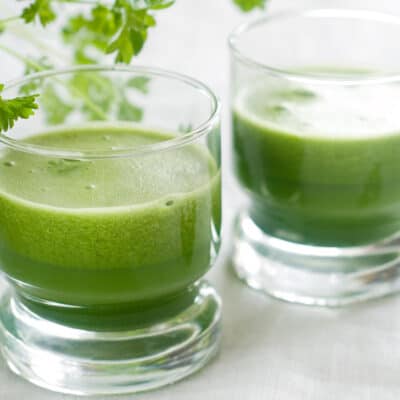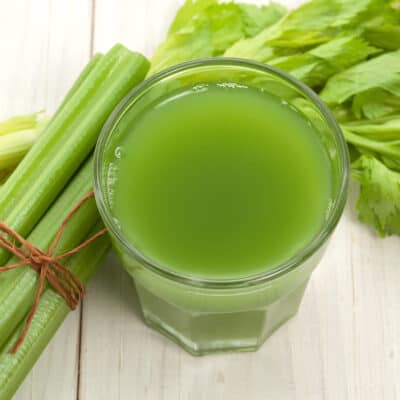Drink 8 glasses of water a day, right? Well, it turns out that it’s not that simple.
As with anything to do with health, quantity matters – but so does quality. In this article, we’ll discuss how to understand your water source, how to properly filter your water, and how to optimize your water intake for your body with some of my favorite tips.
There is so much information we could discuss on the topic of water and hydration, so this article will not be entirely comprehensive, but it will give you a better understanding of your water and how to make it work the best it can for your health. I’ll also share some great resources at the end if you wish to continue learning about water and hydration.
Let’s dive in.
Why Tap Water Can Do More Harm Than Help
Is all water created equal? Research – and my own experiences with my family and clients – say no. Our limited supply of freshwater on earth is often polluted by pharmaceuticals, agricultural runoff, livestock contamination, industrial waste, and more. Not to mention many of our federal standards for water safety are about 40 years old, and millions of Americans drink water in violation of the Safe Drinking Water Act. Understanding what is in your water can help you move forward with making decisions for your health and the health of your loved ones. To see what’s in the tap water that comes into your home, type in your zip code into the EWG’s Tap Water Database.
CHEMICALS IN YOUR WATER
Pharmaceuticals, PFAs, and carcinogens – oh my! The water that comes into your home can contain harmful chemicals that are detrimental to your health. After all – as gross as this sounds – water is often recycled toilet water and/or is contaminated by toilet water. This has been a concern since 1999 when the Environmental Protection Agency alerted the public to the matter, inciting a flurry of research to be done. This study found pharmaceuticals in tap water, including atenolol (a beta-blocker), carbamazepine (an anticonvulsant), gemfibrozil (an antilipidemic), meprobamate (an antianxiety medication), and phenytoin (an anticonvulsant). The concentrations are very low – but low amounts can build up in the body over time, especially if that is your main source of water. Research has also found very small amounts to have a variety of significant effects for children, including cognitive delay, attention deficits and impulsivity, hyperactivity, acute cardiovascular responses to stress, and endocrine and reproductive system disruption. Although low amounts may not seem of concern, we don’t know how steady low amounts contribute to the body’s overall chemical burden – so what may seem insignificant may actually be the tipping point for dis-easement in the body due to an overload of chemicals.
PFAs are perfluoroalkyl substances, or a compound that makes products water- and oil-repellent (such as Teflon). Thousands of industrial facilities in 49 states have been found to be contaminating water with PFAs – and unfortunately, they are “forever chemicals,” meaning they will never break down and only build up in our bodies. PFAs have been found in major metropolitan areas, but are estimated by the Environmental Working Group to have contaminated all of the United States’ major water supply. Exposure to PFAs can result in increased cancer risk, ADHD in children, tooth decay in children, are passed on to the fetus during pregnancy, and are even thought to impact fertility.
Can you get cancer from your water? No one can say that solely the contaminants in your water supply will cause cancer (due to lack of info about other factors, such as lifestyle, environment, stressors, chemical burden, health history, etc), but they will certainly increase your risk. It’s not uncommon to find carcinogenic chemicals in your water, such as bromodichloromethane, chromium, dibromochloromethane, and more. Many of these are common byproducts from chemicals used in an effort to disinfect drinking water, but which have been shown to cause cancer and are common U.S. water contaminants.
Want to know exactly what’s in your water and if it can harm you? Put in your zip code on the EWG’s tapwater database and see how your local facility complies with health standards. Remember, those health standards haven’t been updated for four decades – so legal doesn’t always equal safe.
HEAVY METALS
Even though lead isn’t supposed to be a concern for your home anymore, in 2012 the CDC found 32% of all U.S. houses to have some lead paint, and 22% to have significant lead-based hazards. More than 500,000 children in the U.S. have elevated lead levels in their blood, and partly due to contaminated water, lead pipes, and lead paint (according to the CDC). The health effects of lead have been widely documented with long-lasting effects. Childhood lead exposure can lead to decreased mental health in adulthood, increased criminal behavior in adulthood, sleep problems, decreased brain volume in adolescents, lower cognitive ability, and lower socioeconomic status as adults – and that’s just the tip of the iceberg. More concerning is that 43% of school districts tested positive for lead in their drinking water in 2016-17. For adults, lead exposure is linked to premature death, raised cholesterol levels, and exposure during pregnancy can alter DNA in that mother’s future grandchildren, among many other effects.
Lead isn’t the only concern. Arsenic has a real and dangerous presence in our drinking water, as well as other metals such as aluminum. Even low levels of arsenic in drinking water has been linked to lower IQ in children and adults, increased cancer risk (even years after exposure), impaired fetal development, and early puberty and obesity, among many other concerns. Aluminum is also commonly used as a way to treat water, but no national standard exists for safe levels in drinking water. Did you know that aluminum is considered a neurotoxin? Individuals with autism and Alzheimer’s have been found with higher levels of aluminum in their brains, suggesting that neural pathways are altered by its presence. The American Cancer Society also lists aluminum production as a known human carcinogen. Heavy metals that accumulate in the body are known to cause a wide variety of problems, and I often see them as a root cause of many of my clients’ health problems. Besides removing them from your water (see below), I would recommend detoxing them from your body using this method.
FLUORIDE
Fluoride was added to U.S. drinking water in 1945 and was thought to be one of the greatest advancements in dental health. Yet, the CDC reports that 41% of adolescents have dental fluorosis, which is damage to tooth enamel caused by excess fluoride. So perhaps fluoride does more harm than good? And not just to your teeth. A 2019 study published in a highly esteemed research journal revealed that drinking fluoridated water during pregnancy was associated with lower IQ in children. Study after study – including this meta-analysis – support this link between fluoride exposure and poor neurodevelopment. In fact, The Lancet, a world leading medical journal, classified fluoride as a neurotoxin. Fluoride has also been linked to autism due to its ability to alter the central nervous system and affect cell signaling in combination with aluminum (individuals with autism have higher levels of aluminum in their brains).
Other health effects of fluoride include thyroid dysfunction (including hypothyroidism), renal failure, cardiovascular dysfunction and oxidative stress (setting the stage for cancer), and many other effects that are still being explored. Harvard Public Health Magazine points out that countries that do not fluoridate their water have also seen a drop in cavities due to its widespread use in other hygiene products like toothpaste. So the question is – why is a known neurotoxin being unnecessarily added to our drinking water at poorly regulated levels when it can be absorbed into the bloodstream and affect our health?
CHLORINE
Chlorine is widely used to disinfect drinking water and is heralded as one of the most successful public health measures of the 20th century, meant to remove viruses and bacteria from toilet water cleaned in a water treatment facility. However, chlorinated drinking water has now been discovered to contain and create previously unknown toxic byproducts, which are linked to a variety of birth defects – including heart problems, cleft palate, and major brain defects. One such family of toxic byproducts is trihalomethanes – a largely unregulated group of chemicals that have been found to increase cancer risk, affect fertility and fetal development, and impact the central nervous system, kidneys, liver, and heart. When BPA contaminates our tap water (via PVC pipes, microplastics and more) and becomes chlorinated, research shows it has different, but just as damaging effects as the unmodified BPA on your body’s cell-signaling networks. In addition, drinking chlorinated water has recently been found to be contributing to the mutation of bacteria to resist the effects of antibiotics. The American Chemical Society also stated that chlorine isn’t doing a great job of removing pharmaceuticals from drinking water, which can also contribute to antibiotic resistance and unknown health effects.
PLASTICS
We’ve all heard of BPA and its harmful effects. However, what about plastic nanoparticles that are present in our water? A lab at Washington State University is studying how these invisible plastics travel through our drinking water and accumulate in the environment – yet if they can settle in our lakes and rivers, they are definitely settling in our blood and organs. Their concern is the inadequate removal of these plastics in water treatment plants and the unknown consequences on our environment and our health. Where do these plastics come from? Anything from microbeads in personal hygiene products, to plastic water pipes, to plastic water bottles and the millions of other plastic products we use daily. Another study used metrics to estimate that Americans are ingesting up to 90,000 plastic particles annually due to tap water, bottled water, food packaging, etc. What are the health effects of accumulating plastic in your body? Many are documented, such as infertility, poor brain development, endocrine disruption, and many more, but researchers are still uneasy wondering about the long-term effects that are yet unknown.
How to get rid of plastics in your water and your body? Besides using a filter that removes particles smaller than microplastics, I would recommend detoxing plastics from your body. This can be done in a few ways, but I like Anthony Williams’ anti-plastic tea: equal parts organic fenugreek seed, organic lemon balm, organic mullein, and organic olive leaf. You can also find these teas premixed here and here. Also, taking Dr. Christopher’s Glandular System supplement can help pull out plastics from the body.
A NOTE ABOUT WELL WATER
If your main water source is from a well, I would highly recommend getting it tested at least once a year for contaminants. It’s not uncommon that any of the above contaminants can also find their way into well water, particularly if you live in an agricultural area. You may also need to carefully monitor the levels of certain minerals that come from well water. This is a good resource to read about well water, with more resources at the bottom of the link.
How To Filter Your Drinking Water
I could go on and on about all the things you can find in your tap water, but the real question is: How do you get all that nasty stuff out?
There are a variety of water filters available, and you have to do your research to find the one that will work best for you. My family uses the Berkey filtration system for all the water we use, even for our showers. I have found that this works extremely well for us and has made an important impact on our health. Berkey filters have been tested to remove 99.999% of water contaminants (including viruses, pathogenic bacteria, trihalomethanes, chloride, heavy metals, microorganisms, pharmaceuticals, arsenic, and many more). I have found the water to taste the best out of the Berkey system than other systems. I also love that the system doesn’t need electricity; it’s a simple gravity-fed filtration system.
The Berkey system comes in a variety of sizes, including a small (Travel Berkey), medium (Royal Berkey), and large (Big Berkey), depending on the number of people it will serve. Berkey sports water bottles are even available. I highly recommend also utilizing the fluoride filters (an additional product by Berkey).
It is also possible to install a complete house water filtration system, such as reverse osmosis. This can be a good system for removing water contaminants, if done properly. My only concerns about reverse osmosis system are as follows:
- The systems that use a large holding tank (typically found under the kitchen sink) can be prone to mildew and stagnant water (leading to the growth of bacteria) if the tank isn’t used quickly.
- Reverse osmosis removes all minerals from the water. If you use a reverse osmosis, it is important to remineralize your water. Adding a few fresh sprigs of parsley to your water and letting it steep for a few hours will remineralize it and boost the energy of the water. Another option is adding a high quality mineral supplement to your water (such as this one or this one). If you’re using it for drinking water, you can also make parsley water.
- The size of the membranes that the water is pushed through needs to be smaller than the particles the product claims to filter. Also, make sure to know what kind of maintenance the membranes need, and how regularly they need it. Some membranes can have build up that can recontaminate the water. I highly recommend doing your research on this before spending the money on a reverse osmosis system to make sure the system is a good one and you know the care it needs.
For a more thorough comparison of multiple water filtration systems, I recommend the below resources:
- EWG Water Filtration Guide
- Heal Thy Self Podcast: Water Quality Facts, Water Filter Review, Guest Tracy Duhs
- HYDRATE podcast with Tracy Duhs
To learn more about your water, here are some other resources:
- Dark Waters film
- The latest on tap water regulation and contaminants by EWG
- Tap Water Database
- Well water resources
Hydration Tips
I love talking about hydration, so a follow-up post about the secrets to optimizing your drinking water to deeply hydrate your body is coming your way! However, for now, here’s a few tips:
- Drink at least half your body weight in ounces per day (for example: 200 lbs body weight = 100 ounces)
- Add a squeeze of citrus or a slice of cucumber to your drinking water to increase mineralization and the ability of your cells to absorb the water
- Put your water in the sun! The sun gives us thousands of minerals and vitamins. Letting sun shine on your water for 4+ hours raises the life energy and health benefits of your water.
Stay tuned for more! I hope this article gets you thinking critically about the water you drink and gives you information to move forward making informed decisions about your health. Cheers to good clean water!
Blessings,
Amber
To get exclusive recipes, health info, and wellness tips straight to your inbox, subscribe here.
To begin your healing journey today with my starting protocol, register here.









